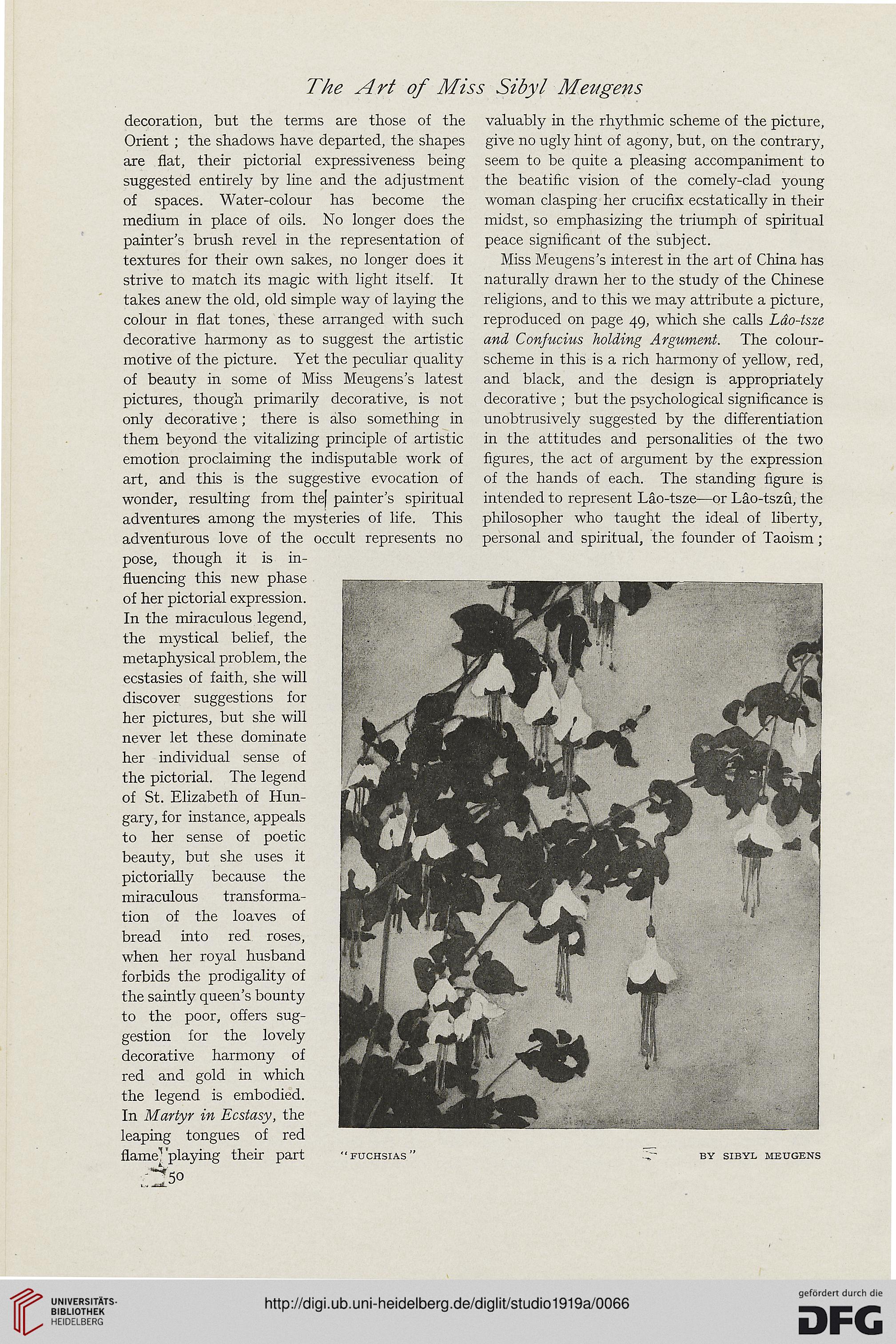The Art of Miss Sibyl Men gens
decoration, but the terms are those of the valuably in the rhythmic scheme of the picture,
Orient ; the shadows have departed, the shapes give no ugly hint of agony, but, on the contrary,
are flat, their pictorial expressiveness being seem to be quite a pleasing accompaniment to
suggested entirely by line and the adjustment the beatific vision of the comely-clad young
of spaces. Water-colour has become the woman clasping her crucifix ecstatically in their
medium in place of oils. No longer does the midst, so emphasizing the triumph of spiritual
painter's brush revel in the representation of peace significant of the subject,
textures for their own sakes, no longer does it Miss Meugens's interest in the art of China has
strive to match its magic with light itself. It naturally drawn her to the study of the Chinese
takes anew the old, old simple way of laying the religions, and to this we may attribute a picture,
colour in flat tones, these arranged with such reproduced on page 49, which she calls Ldo-tsze
decorative harmony as to suggest the artistic and Confucius holding Argument. The colour-
motive of the picture. Yet the peculiar quality scheme in this is a rich harmony of yellow, red,
of beauty in some of Miss Meugens's latest and black, and the design is appropriately
pictures, though primarily decorative, is not decorative ; but the psychological significance is
only decorative; there is also something in unobtrusively suggested by the differentiation
them beyond the vitalizing principle of artistic in the attitudes and personalities of the two
emotion proclaiming the indisputable work of figures, the act of argument by the expression
art, and this is the suggestive evocation of of the hands of each. The standing figure is
wonder, resulting from thef painter's spiritual intended to represent Lao-tsze—or Lao-tszu, the
adventures among the mysteries of life. This philosopher who taught the ideal of liberty,
adventurous love of the occult represents no personal and spiritual, the founder of Taoism ;
pose, though it is in-
fluencing this new phase
of her pictorial expression.
In the miraculous legend,
the mystical belief, the
metaphysical problem, the
ecstasies of faith, she will
discover suggestions for
her pictures, but she will
never let these dominate
her individual sense of
the pictorial. The legend
of St. Elizabeth of Hun-
gary, for instance, appeals
to her sense of poetic
beauty, but she uses it
pictorially because the
miraculous transforma-
tion of the loaves of
bread into red roses,
when her royal husband
forbids the prodigality of
the saintly queen's bounty
to the poor, offers sug-
gestion for the lovely
decorative harmony of
red and gold in which
the legend is embodied.
In Martyr in Ecstasy, the
leaping tongues of red
flame1 "playing their part "fuchsias" by sibyl meugens
.^50
decoration, but the terms are those of the valuably in the rhythmic scheme of the picture,
Orient ; the shadows have departed, the shapes give no ugly hint of agony, but, on the contrary,
are flat, their pictorial expressiveness being seem to be quite a pleasing accompaniment to
suggested entirely by line and the adjustment the beatific vision of the comely-clad young
of spaces. Water-colour has become the woman clasping her crucifix ecstatically in their
medium in place of oils. No longer does the midst, so emphasizing the triumph of spiritual
painter's brush revel in the representation of peace significant of the subject,
textures for their own sakes, no longer does it Miss Meugens's interest in the art of China has
strive to match its magic with light itself. It naturally drawn her to the study of the Chinese
takes anew the old, old simple way of laying the religions, and to this we may attribute a picture,
colour in flat tones, these arranged with such reproduced on page 49, which she calls Ldo-tsze
decorative harmony as to suggest the artistic and Confucius holding Argument. The colour-
motive of the picture. Yet the peculiar quality scheme in this is a rich harmony of yellow, red,
of beauty in some of Miss Meugens's latest and black, and the design is appropriately
pictures, though primarily decorative, is not decorative ; but the psychological significance is
only decorative; there is also something in unobtrusively suggested by the differentiation
them beyond the vitalizing principle of artistic in the attitudes and personalities of the two
emotion proclaiming the indisputable work of figures, the act of argument by the expression
art, and this is the suggestive evocation of of the hands of each. The standing figure is
wonder, resulting from thef painter's spiritual intended to represent Lao-tsze—or Lao-tszu, the
adventures among the mysteries of life. This philosopher who taught the ideal of liberty,
adventurous love of the occult represents no personal and spiritual, the founder of Taoism ;
pose, though it is in-
fluencing this new phase
of her pictorial expression.
In the miraculous legend,
the mystical belief, the
metaphysical problem, the
ecstasies of faith, she will
discover suggestions for
her pictures, but she will
never let these dominate
her individual sense of
the pictorial. The legend
of St. Elizabeth of Hun-
gary, for instance, appeals
to her sense of poetic
beauty, but she uses it
pictorially because the
miraculous transforma-
tion of the loaves of
bread into red roses,
when her royal husband
forbids the prodigality of
the saintly queen's bounty
to the poor, offers sug-
gestion for the lovely
decorative harmony of
red and gold in which
the legend is embodied.
In Martyr in Ecstasy, the
leaping tongues of red
flame1 "playing their part "fuchsias" by sibyl meugens
.^50




